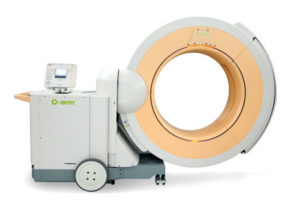What is minimally invasive spine surgery?
As evident by its name, minimally invasive spine surgery is spine surgery designed to be the least invasive possible. There are a variety of minimally invasive techniques that can involve delivery of special instruments and implants through through a small incision.
The most common type of minimally invasive spine surgery uses tubular dilators to widen a small incision. The dilators spread the muscle apart, instead of using the long, deep cuts through muscle associated with traditional spine surgery. The surgeon then works through the widened opening with special tools. Because the opening was stretched and not cut, it is able to close after surgery is complete. As a result, the patient may experience less scarring and a faster recovery time than traditional spine surgery.
Image Guided
 Sophisticated imaging tools, like StealthStation1 and a special O-arm scanner1 that produces images all around the body, are used by the surgeon to create a virtual image of your spine that she uses to observe screw placement and trajectory as she operates. By using this technology, the surgeon is able to perform the operation with much more precise placement accuracy. This decreases the chance for non-union or failure to fuse, making it the safest technique for doctors performing minimally invasive spine surgery.
Sophisticated imaging tools, like StealthStation1 and a special O-arm scanner1 that produces images all around the body, are used by the surgeon to create a virtual image of your spine that she uses to observe screw placement and trajectory as she operates. By using this technology, the surgeon is able to perform the operation with much more precise placement accuracy. This decreases the chance for non-union or failure to fuse, making it the safest technique for doctors performing minimally invasive spine surgery.
Benefits
There are many benefits to minimally invasive spine surgery. Blood loss, pain, and muscle damage are less than that required of traditional spinal surgery, so the patient may be able to get back on their feet sooner, with a shorter recovery time. A shorter hospital stay may be required of the patient, as well as a reduced recovery time. Only your physician can determine the length of your hospital stay.
Options
Every spine is different, so not everyone is eligible for minimally invasive spine surgery. Your surgeon may decide to perform traditional spine surgery if the right conditions for minimally invasive spine surgery are not met. Only your doctor can determine if you are a good candidate for minimally invasive spine surgery.
Risk statement
Risks of minimally invasive spine surgery include nonunion, allergic reaction, blood clots, pain, and in some cases, death. This article is intended only for information purposes and should not replace the advice of a physician. Please refer to your doctor for all questions.
- O-arm and StealthStation are both trademarks of Medtronic.


